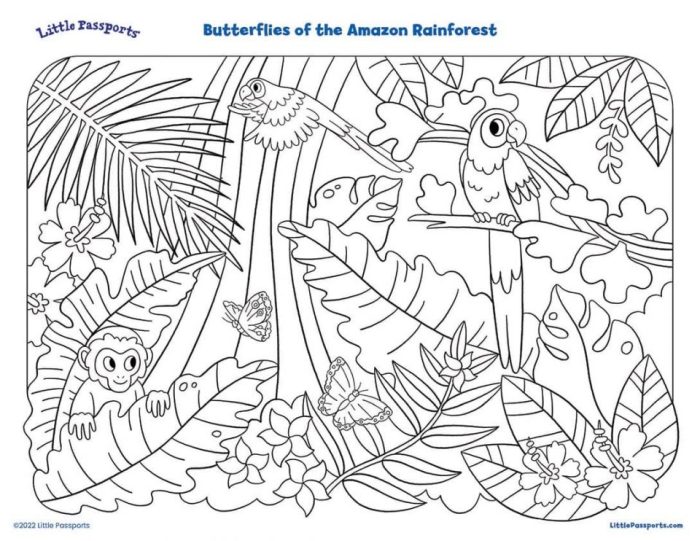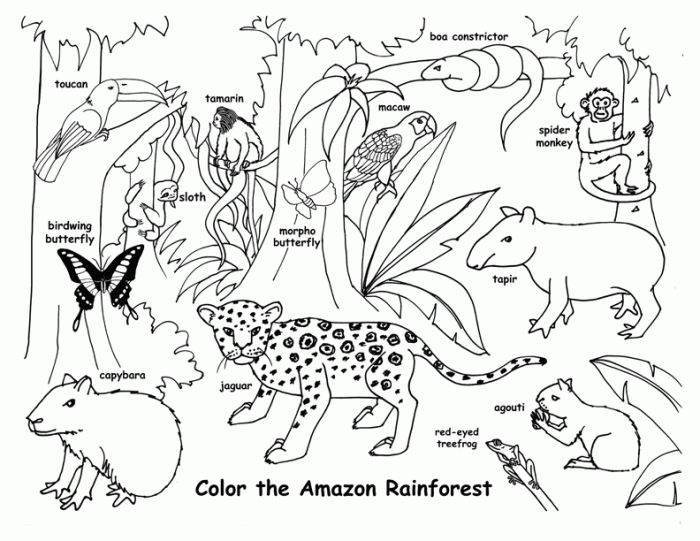Design Elements of Effective Rainforest Animal Coloring Pages: Rainforest Animals Coloring Page

Rainforest animals coloring page – Creating truly captivating rainforest animal coloring pages requires a delicate balance of artistry and child-friendly design. A successful page isn’t just about pretty pictures; it’s about sparking imagination and providing a satisfying coloring experience. Let’s delve into the key elements that transform a simple Artikel into a jungle adventure.
Design Elements Contributing to Engaging Rainforest Animal Coloring Pages
The effectiveness of a coloring page hinges on several crucial design elements. A well-designed page considers the age range, skill level, and overall appeal to the target audience. Ignoring these aspects can lead to a coloring page that’s either too challenging or too simplistic, resulting in a less-than-thrilling experience.
- Clear and Simple Artikels: Lines should be bold enough for easy tracing, but not so thick that they overwhelm the image. A balance is key, especially for younger children. Think of the difference between a toddler’s crayon strokes and the fine lines of an adult’s detailed drawing – we need something in the middle.
- Age-Appropriate Detail: The level of detail should align with the intended age group. Younger children benefit from simpler designs with fewer intricate details, while older children might appreciate more complex patterns and textures within the animals and surroundings.
- Visually Appealing Animals: Choose animals that are instantly recognizable and visually engaging. Bright, colorful animals, such as macaws, toucans, and monkeys, are excellent choices. Consider adding a playful expression to the animals to increase their appeal.
- Interesting Background Elements: Don’t just focus on the animals; create an immersive rainforest environment. Include lush foliage, vibrant flowers, waterfalls, and other rainforest features to enrich the overall scene. This provides a more captivating setting for the animals and adds extra coloring opportunities.
- Strategic White Space: Leave enough space around the animals and background elements to prevent the page from feeling cluttered. This space allows children to color without accidentally going outside the lines and also makes the page less visually overwhelming.
Sample Coloring Page Layout, Rainforest animals coloring page
Imagine a coloring page featuring a vibrant macaw perched on a branch overhanging a sparkling waterfall. The macaw’s plumage is detailed but not overly complex, allowing for easy coloring. Surrounding the macaw are lush, leafy branches and colorful orchids. The waterfall cascades down into a small pool at the bottom of the page, offering a smooth transition to the bottom margin.
Right, so you’re into rainforest animals coloring pages, yeah? Loads of fun, getting all creative with jaguars and sloths. But if you fancy a bit of a change, check out these printable coloring pictures of zoo animals – lions and tigers and bears, oh my! Then, once you’ve had a bash at those, you can totally get back to those awesome rainforest critters.
Brilliant, innit?
The entire scene is enclosed within a subtly decorative border, providing a frame without detracting from the central image. The background includes a few strategically placed leaves and vines to add visual interest without overcrowding the macaw.
Comparison of Color Palettes for Rainforest Animal Coloring Pages
Different color palettes evoke different moods and are suitable for different age groups. A bright, saturated palette might be ideal for younger children, while a more muted palette could appeal to older children or adults.
| Color Palette Name | Description | Target Age Group | Effectiveness Rating (1-5) |
|---|---|---|---|
| Jungle Jewel Tones | Vibrant greens, blues, yellows, and reds. High saturation. | 3-7 years | 5 |
| Subtle Rainforest Hues | Muted greens, browns, and deep blues. Lower saturation. | 8-12 years | 4 |
| Tropical Sunset | Warm oranges, pinks, and purples, with hints of green. | All ages | 4 |
| Deep Jungle Greens | Various shades of green, with touches of brown and black. | Adults | 3 |
Impact of Line Thickness and Detail on Coloring Page Appeal and Difficulty
The thickness and detail of the lines directly impact the coloring page’s appeal and difficulty. Thin lines require more precision and are better suited for older children or adults who enjoy intricate coloring. Thicker lines are easier for younger children to color within, leading to a more satisfying experience and reducing frustration. For example, a coloring page with thin lines outlining the intricate scales of a reptile would be significantly more challenging than a page with thick lines outlining a simple cartoon monkey.
The choice should be guided by the target audience’s skill level and the desired level of complexity.
Illustrations and Descriptions of Rainforest Animals

Embark on a whimsical journey into the heart of the rainforest, where the vibrant tapestry of life unfolds in a symphony of sights and sounds. We’ll explore the remarkable creatures that call this lush ecosystem home, focusing on their unique physical attributes and astonishing adaptations. Prepare for a delightful dive into the extraordinary!
Detailed Descriptions of Five Rainforest Animals
Let’s meet five fascinating rainforest inhabitants. First, the resplendent Three-toed Sloth, a master of slow-motion, with its incredibly long limbs and surprisingly strong claws, perfectly designed for hanging upside down from branches. Next, the elusive Jaguar, a powerful feline boasting a breathtaking rosette pattern on its tawny coat, a natural camouflage in the dappled sunlight filtering through the rainforest canopy.
Then there’s the vibrant Scarlet Macaw, a flamboyant flyer with intensely red, yellow, and blue feathers, a dazzling spectacle against the green backdrop. The equally striking Poison Dart Frog, small but mighty, flaunts a kaleidoscope of colors – often bright reds, yellows, and blues – a warning sign of its potent toxicity. Finally, the Amazonian Anaconda, a colossal snake, with its impressive size and incredibly strong muscles, slithers through the waterways, a true apex predator of the rainforest.
Visual Descriptions of Textures and Patterns
The Three-toed Sloth’s fur is surprisingly coarse, almost wiry, providing excellent protection from the elements and serving as a habitat for algae, giving it a greenish hue. The Jaguar’s coat showcases a remarkable rosette pattern, each rosette a unique swirl of dark brown or black spots against a golden-yellow background, creating a camouflage masterpiece. The Scarlet Macaw’s feathers are incredibly smooth and glossy, each feather reflecting light with an almost iridescent sheen, adding to their vibrant colors.
Visual Description of a Rainforest Habitat
Picture the vibrant green canopy of the Amazon rainforest, teeming with life. A family of spider monkeys swings effortlessly through the branches of giant kapok trees, their calls echoing through the humid air. Below, a vibrant green carpet of vegetation covers the forest floor, punctuated by the bright colors of exotic flowers and fungi. A sloth hangs motionless from a branch, camouflaged perfectly against the leaves.
In the shadows, a jaguar silently stalks its prey, its powerful muscles coiled and ready to strike. The air hums with the sounds of insects, birds, and the distant roar of a howler monkey.
Unique Adaptations of Two Rainforest Animals
The Three-toed Sloth’s incredibly slow metabolism and camouflage, achieved through algae growing in its fur, allows it to remain undetected by predators and conserve energy in its energy-poor environment. The Poison Dart Frog’s bright, vibrant coloration serves as a warning to potential predators, signaling its highly toxic skin – a potent defense mechanism that effectively deters any would-be attackers.
Question Bank
Where can I find free rainforest animal coloring pages?
Many websites offer free printable rainforest animal coloring pages. A simple Google search should yield numerous results.
Are there coloring pages suitable for toddlers?
Yes! Look for pages with simpler designs and thicker lines, making them easier for little hands to color.
Can I use these coloring pages for classroom activities?
Absolutely! They’re a great tool for teaching about rainforest habitats and animals. Consider incorporating them into lesson plans.
What type of paper is best for coloring these pages?
Thicker paper, like cardstock, is ideal to prevent bleed-through, especially with markers or watercolors.
